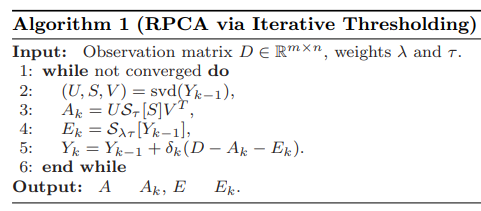Robust PCA
Principal Component Analysis(PCA)는 복잡한 다차원의 행렬을 낮은 차원의 데이터로 변환하는 방법이다. 원 데이터의 정보를 잘 보존한 채로 낮은 차원의 데이터로 변환해 연산도 줄고 noise도 제거가 되는 효과가 있어 데이터 전처리에 다양하게 쓰이는 기법이다.
하지만 만약 원 데이터가 noise에 영향을 많이 받아 알아보기 힘든 "grossly corrupted" 된 데이터에서는 사용하기 어렵다.
이를 해결하기 위해서 나타난 방법 중 하나가 Robust PCA (RPCA) [1] 기법이다. 정의는 다음과 같다.
Given , where and are unknown, but is known to be low rank and is known to be sparse, recover from
Noise가 낀 원본 데이터 에서 노이즈가 제거된 를 찾는 방법이다. 이 때, 가 low-rank 이고 가 sparse 해야 한다는 가정이 있어야 한다.
여기서 noise와 관련된 행렬 가 sparse 해야 한다는데, 어떻게 원본 데이터가 "grossly corrupted" 될 수 있는지 의문이었다. 내가 이해한 바로는 는 sparse 하지만 그 magnitude, 정도는 arbitrary할 수 있어 sparse한 로도 원본 데이터가 충분히 영향을 많이 받을 수 있다는 것으로 이해하였다.
수식으로는 다음과 같다
는 L0 norm이다.
이 때, 위 식은 NP-Hard 문제가 합쳐진 것으로 nonconvex-problem이 된다. 따라서 위 수식을 다음과 같이 relax할 수 있다.
는 nuclear norm, 는 L1 norm이다.
즉 가 constraint가 되는 convex optimization 문제가 된다.
Augmented Lagrangian Multiplier Method
RPCA를 풀 수 있는 다양한 방법들이 있는데, 그 중 Augmented Lagrangian Multiplier [2]를 이용한 방법을 소개한다.
RPCA via Iterative Thresholding
[7] [24] 에 의하면 optimal 한 는 singular value decomposition (SVD)을 이용해서 유도할 수 있다.
여기서
여기서 이다.
Augmented Lagrangian Multiplier (ALM)
행렬 (혹은 데이터) 에 대하여
이 때, augmented Lagrangian Function을 다음과 같이 나타낸다.
여기서 는 Frobenius norm, 으로 의 주대각선의 성분들의 합을 나타낸다.
위 식에서 optimal 를 찾기 위해서는 을 구하면 된다.
같은 방식으로 RPCA에 ALM을 적용하면 다음과 같다.
그러면 Lagrangian function은 다음과 같이 된다.
마찬가지로 optimal한 를 얻기 위해서는 을 구하면 된다.
Reference
[1] J. Wright, A. Ganesh, S. Rao, and Y. Ma, “Robust principal component analysis: Exact recovery of corrupted low-rank matrices,” Adv. Neural Inf.
Process. Syst., vol. 87, no. 4, pp. 2080–2088, 2009
[2] Z. Lin, M. Chen, and Y. Ma, “The augmented Lagrange multiplier method for exact recovery of corrupted low-rank matrices,” unpublished paper, 2010. [Online]. Available: https://arxiv.org/abs/1009.5055v1
[3] Cai, J., Cand`es, E., Shen, Z.: A singular value thresholding algorithm for matrix completion. preprint, code available at http://svt.caltech.edu/code.html (2008)
[4] Yin, W., Hale, E., Zhang, Y.: Fixed-point continuation for ℓ1-minimization: methodology
and convergence. preprint (2008)



